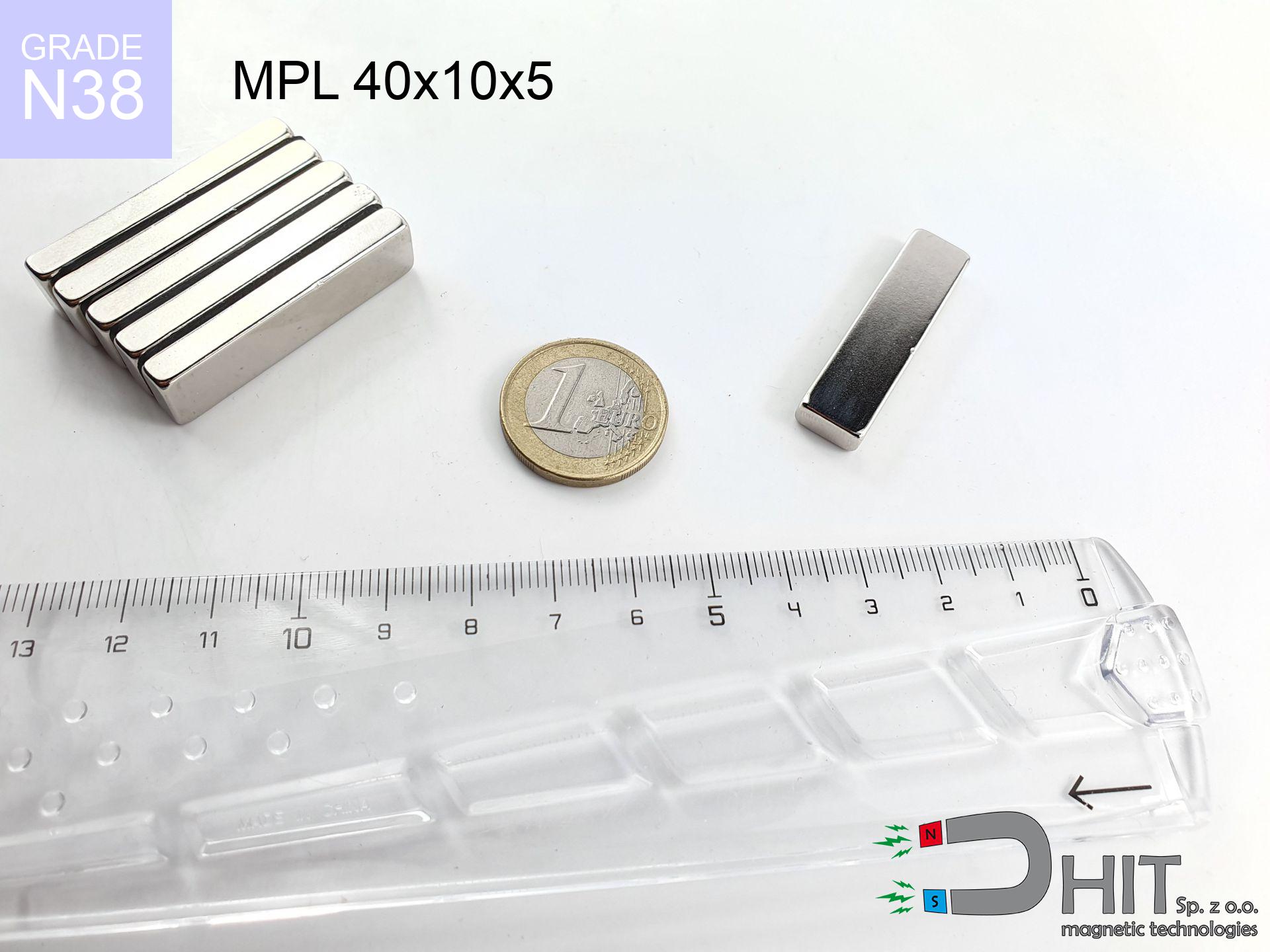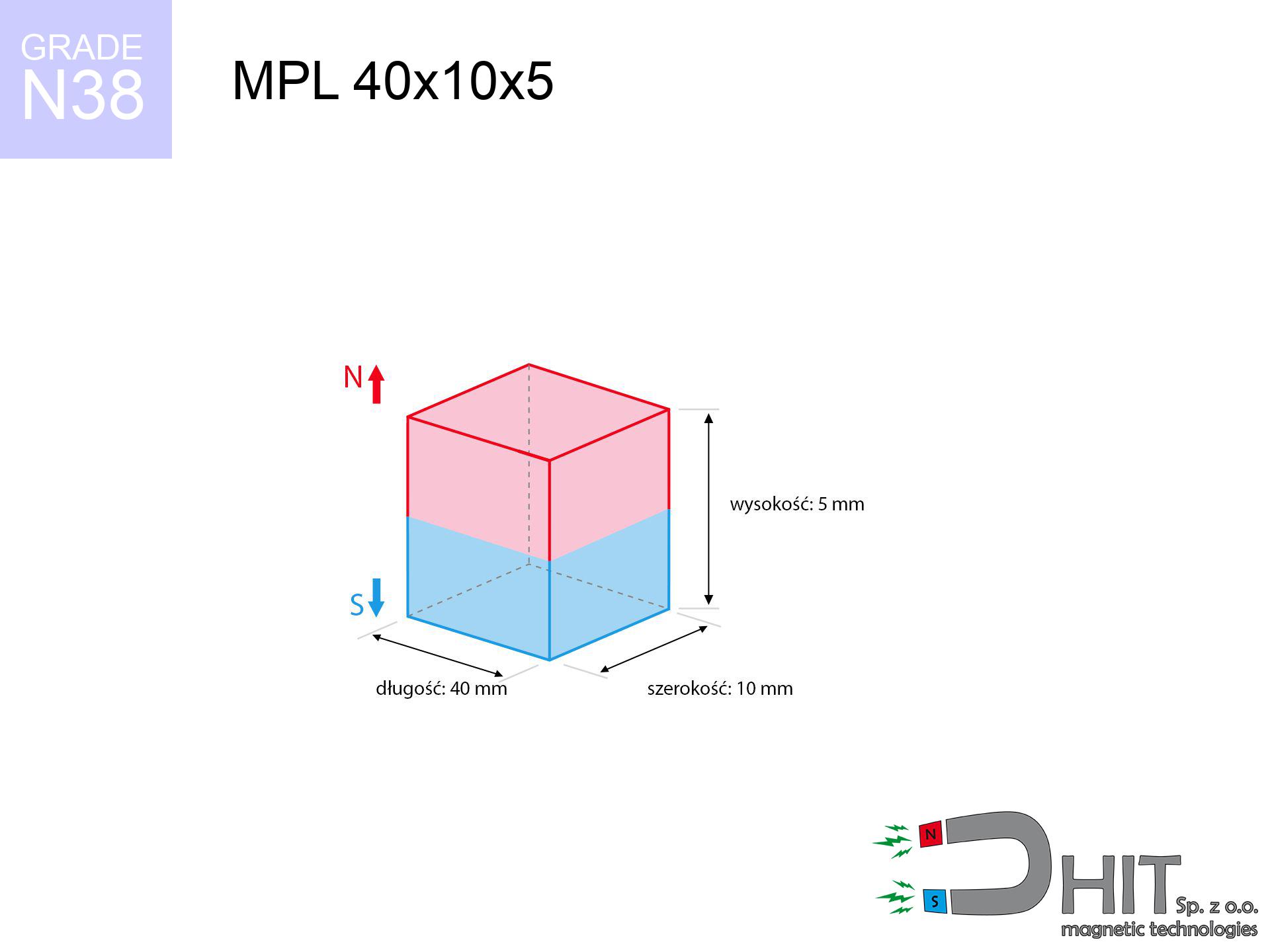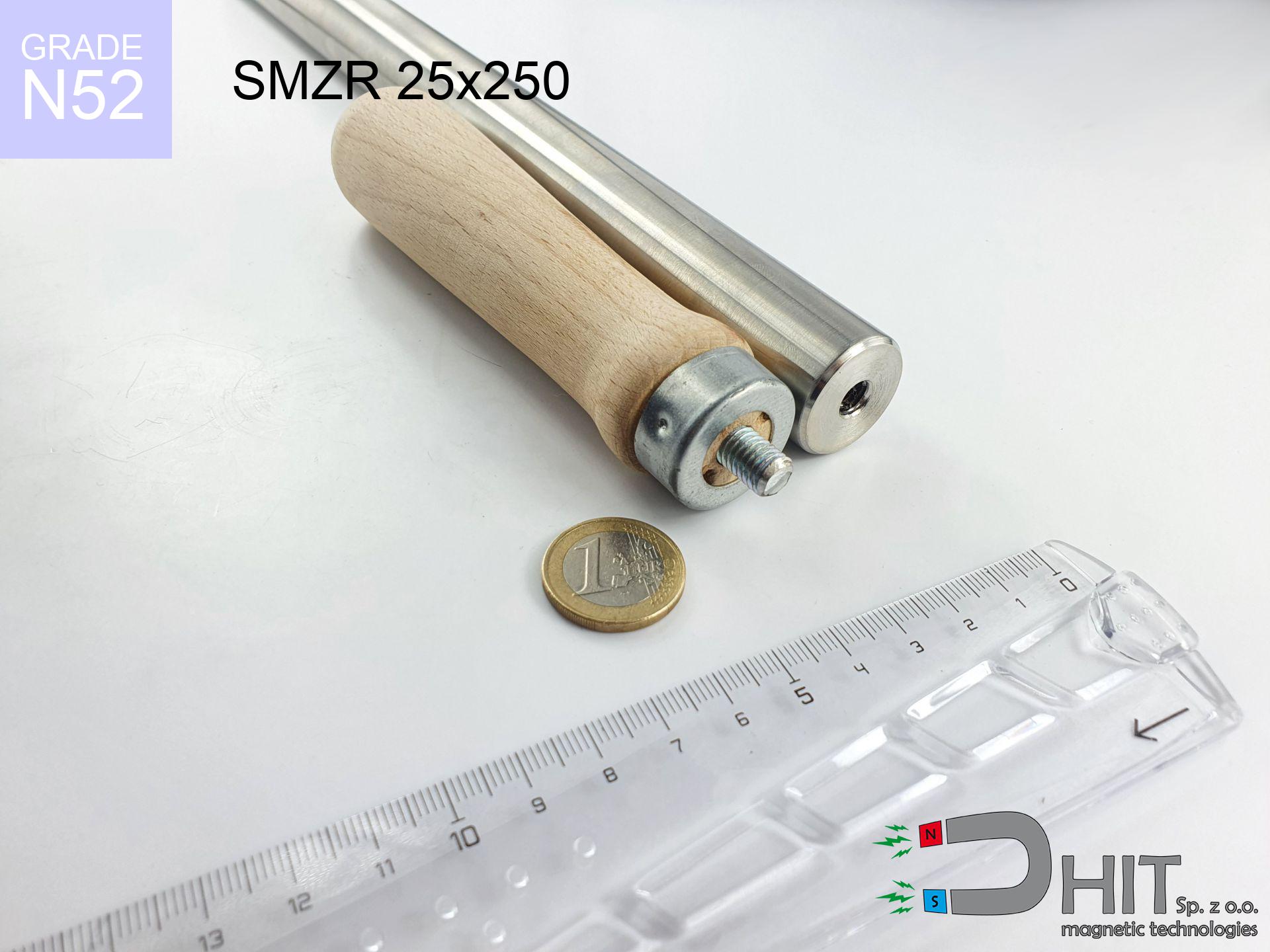MPL 40x10x5 / N38 - lamellar magnet
lamellar magnet
Catalog no 020152
GTIN: 5906301811589
length
40 mm [±0,1 mm]
Width
10 mm [±0,1 mm]
Height
5 mm [±0,1 mm]
Weight
15 g
Magnetization Direction
↑ axial
Load capacity
7.9 kg / 77.47 N
Magnetic Induction
321.37 mT
Coating
[NiCuNi] nickel
6.03 ZŁ with VAT / pcs + price for transport
4.90 ZŁ net + 23% VAT / pcs
bulk discounts:
Need more?Need advice?
Call us
+48 888 99 98 98
otherwise drop us a message through
inquiry form
our website.
Lifting power along with form of a magnet can be reviewed with our
modular calculator.
Same-day shipping for orders placed before 14:00.
Magnetic properties of material N38
Physical properties of sintered neodymium magnets Nd2Fe14B at 20°C
Shopping tips
Pros as well as cons of neodymium magnets.
Besides their durability, neodymium magnets are valued for these benefits:
- They do not lose magnetism, even during around ten years – the reduction in strength is only ~1% (theoretically),
- They possess excellent resistance to weakening of magnetic properties as a result of opposing magnetic fields,
- In other words, due to the smooth finish of nickel, the element becomes visually attractive,
- Magnetic induction on the working part of the magnet is impressive,
- Neodymium magnets are characterized by very high magnetic induction on the magnet surface and are able to act (depending on the shape) even at a temperature of 230°C or more...
- Thanks to freedom in shaping and the capacity to modify to complex applications,
- Universal use in electronics industry – they serve a role in mass storage devices, brushless drives, precision medical tools, also technologically advanced constructions.
- Compactness – despite small sizes they provide effective action, making them ideal for precision applications
Characteristics of disadvantages of neodymium magnets: weaknesses and usage proposals
- At very strong impacts they can break, therefore we recommend placing them in steel cases. A metal housing provides additional protection against damage, as well as increases the magnet's durability.
- Neodymium magnets lose their power under the influence of heating. As soon as 80°C is exceeded, many of them start losing their power. Therefore, we recommend our special magnets marked [AH], which maintain durability even at temperatures up to 230°C
- Due to the susceptibility of magnets to corrosion in a humid environment, we recommend using waterproof magnets made of rubber, plastic or other material resistant to moisture, when using outdoors
- Limited ability of producing nuts in the magnet and complex shapes - preferred is casing - mounting mechanism.
- Health risk resulting from small fragments of magnets are risky, in case of ingestion, which gains importance in the aspect of protecting the youngest. Additionally, tiny parts of these devices are able to be problematic in diagnostics medical in case of swallowing.
- Due to expensive raw materials, their price is relatively high,
Maximum magnetic pulling force – what it depends on?
The lifting capacity listed is a result of laboratory testing conducted under specific, ideal conditions:
- with the contact of a yoke made of low-carbon steel, guaranteeing full magnetic saturation
- with a cross-section no less than 10 mm
- characterized by even structure
- under conditions of no distance (metal-to-metal)
- during detachment in a direction vertical to the plane
- at temperature approx. 20 degrees Celsius
Magnet lifting force in use – key factors
Please note that the magnet holding will differ depending on elements below, in order of importance:
- Space between magnet and steel – every millimeter of separation (caused e.g. by veneer or dirt) diminishes the pulling force, often by half at just 0.5 mm.
- Loading method – catalog parameter refers to pulling vertically. When applying parallel force, the magnet holds significantly lower power (typically approx. 20-30% of maximum force).
- Steel thickness – too thin steel does not accept the full field, causing part of the flux to be lost to the other side.
- Material type – the best choice is pure iron steel. Cast iron may have worse magnetic properties.
- Base smoothness – the more even the plate, the larger the contact zone and stronger the hold. Roughness acts like micro-gaps.
- Temperature – heating the magnet causes a temporary drop of induction. Check the thermal limit for a given model.
* Lifting capacity was determined with the use of a polished steel plate of suitable thickness (min. 20 mm), under vertically applied force, whereas under attempts to slide the magnet the load capacity is reduced by as much as 5 times. Moreover, even a minimal clearance {between} the magnet’s surface and the plate lowers the lifting capacity.
Precautions when working with neodymium magnets
GPS and phone interference
Remember: rare earth magnets generate a field that confuses sensitive sensors. Keep a safe distance from your mobile, device, and navigation systems.
Power loss in heat
Monitor thermal conditions. Exposing the magnet above 80 degrees Celsius will ruin its magnetic structure and strength.
Shattering risk
Watch out for shards. Magnets can fracture upon violent connection, ejecting shards into the air. We recommend safety glasses.
Do not underestimate power
Before use, read the rules. Uncontrolled attraction can destroy the magnet or hurt your hand. Think ahead.
Swallowing risk
These products are not intended for children. Accidental ingestion of several magnets may result in them attracting across intestines, which constitutes a critical condition and necessitates immediate surgery.
Nickel allergy
Medical facts indicate that nickel (the usual finish) is a common allergen. For allergy sufferers, avoid touching magnets with bare hands or select coated magnets.
Bone fractures
Danger of trauma: The attraction force is so great that it can result in blood blisters, pinching, and broken bones. Use thick gloves.
Machining danger
Combustion risk: Neodymium dust is explosive. Do not process magnets in home conditions as this risks ignition.
Life threat
Medical warning: Neodymium magnets can deactivate pacemakers and defibrillators. Stay away if you have medical devices.
Data carriers
Very strong magnetic fields can corrupt files on credit cards, HDDs, and storage devices. Maintain a gap of min. 10 cm.
Caution!
Want to know more? Read our article: Are neodymium magnets dangerous?





![BM 650x180x70 [4x M8] - magnetic beam BM 650x180x70 [4x M8] - magnetic beam](https://cdn3.dhit.pl/graphics/products/bm-650x180x70-4x-m8-laj.jpg)
![SM 32x100 [2xM8] / N52 - magnetic separator SM 32x100 [2xM8] / N52 - magnetic separator](https://cdn3.dhit.pl/graphics/products/sm-32x100-2xm8-war.jpg)


